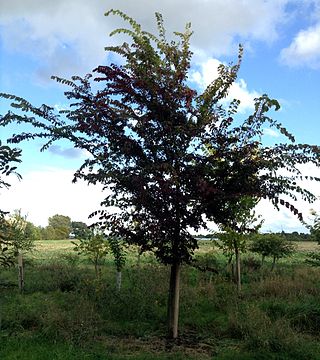Related Research Articles

Ulmus 'Frontier' is an American hybrid cultivar, a United States National Arboretum introduction derived from a crossing of the European Field Elm Ulmus minor with the Chinese Elm Ulmus parvifolia in 1971. Released in 1990, the tree is a rare example of the hybridization of spring- and autumn-flowering elms. Tested in the US National Elm Trial coordinated by Colorado State University, 'Frontier' averaged a survival rate of 74% after 10 years.

Ulmus 'Morton' is an elm cultivar cloned from a putative intraspecific hybrid planted at the Morton Arboretum in 1924, which itself originated as seed collected from a tree at the Arnold Arboretum in Massachusetts. Although this tree was originally identified as Ulmus crassifolia, it is now believed to have been a hybrid of the Japanese elm and Wilson's elm. Accolade has proven to be the most successful cultivar tested in the US National Elm Trial, averaging a survival rate of 92.5% overall. It had also become the most commonly planted elm in the US by 2023.

Ulmus parvifolia 'UPMTF' is a Chinese Elm cultivar that was found in a field at Moon's Tree Farm, Atlanta, Georgia, in 1993 and raised by Moon's Tree Farm nursery. It was patented in 2000. It is notable for its upright ascending branches.
The Chinese Elm cultivar Ulmus parvifolia 'Burgundy' was selected for its autumn foliage by Dr Michael Dirr and A. E. Richards from a tree on the University of Georgia campus, and first described in 1990.

Ulmus parvifolia 'Emer II' or 'Emerald Vase' is a Chinese Elm cultivar selected by Dr. Michael A. Dirr and cloned in the late 1980s from a tree planted circa 1910 on the University of Georgia campus at Athens, that had survived ice-storms undamaged. It was patented in 1991.
The Chinese Elm cultivar Ulmus parvifolia 'Emer I' or 'Emerald Isle' was cloned from a tree planted circa 1920 on the University of Georgia campus at Athens.

The Chinese Elm cultivar Ulmus parvifolia 'Drake' was marketed by the Monrovia Nursery of Azusa, California, first appearing in their 1952–1953 catalogue.
The Chinese Elm cultivar Ulmus parvifolia 'Dynasty' is a United States National Arboretum introduction resulting from a controlled crossing of two trees of Korean origin. First described in 1984, it is reputed to be very fast-growing.
The Chinese Elm cultivar Ulmus parvifolia 'Hallelujah' is one of three American introductions made circa 1992 that were selected for their cold hardiness. 'Hallelujah' is known to have withstood -37 °C (-35 °F) in Missouri. The tree was first listed by the Arborvillage Nursery, Holt, Missouri, in its 1993–1994 catalogue.
The Chinese Elm cultivar Ulmus parvifolia 'Matthew' is one of three American introductions selected for their cold hardiness.
The Chinese Elm cultivar Ulmus parvifolia 'Milliken' is another American introduction.
The Chinese Elm cultivar Ulmus parvifolia 'Pathfinder' was raised by A. M. Townsend of the USDA National Arboretum and registered in 1990.

The Chinese Elm cultivar Ulmus parvifolia 'Sempervirens' is an American introduction from south China, commonly known by the synonym 'Evergreen'. It was first listed by Bailey & Bailey in Hortus Second, 747, 1941.
The Chinese Elm cultivar Ulmus parvifolia 'Ohio' was raised by A. M. Townsend at the USDA National Arboretum, and released in 1992.

The Chinese Elm cultivar Ulmus parvifolia 'Frosty', or 'Frosty' lacebark elm, was intended primarily as a dwarf variegated variety. Krüssmann (1976) states that it was raised in Japan. It was first distributed by the Mitsch Nursery, Oregon, USA.

The Chinese Elm cultivar Ulmus parvifolia 'King's Choice', patented in 1985, is one of the early American selections best known for its winter hardiness, being able to withstand temperatures of -30 degrees Celsius. It was originally selected for its "outstanding growth ".
The Chinese Elm cultivar Ulmus parvifolia 'Glory' is one of the early American selections, best known for its winter hardiness. It does not appear in Santamour and Bentz's 'Updated Checklist of Elm (Ulmus) Cultivars for use in North America' (1995).
The Chinese Elm cultivar Ulmus parvifolia 'Cork Bark' or 'Corticosa is a North American clone.

The Chinese Elm cultivar Ulmus parvifolia 'Seiju' is a dwarf variety, a sport of 'Hokkaido'.
The Chinese Elm cultivar Ulmus parvifolia 'Garden City Clone' was raised in Kansas. The champion tree was 18 m tall in 1993; however, the name 'Garden City Clone' is not officially recognized.
References
- ↑ Santamour, Frank S.; Bentz, Susan E. (May 1995). "Updated Checklist of Elm (Ulmus) Cultivars for use in North America". Journal of Arboriculture. 21 (3): 122–131. Retrieved 20 June 2016.
- ↑ "Elm Leaf Beetle Survey". Archived from the original on 2011-07-19. Retrieved 17 July 2017.
- ↑ U. parvifolia 'Elsmo', Dawes Arboretum